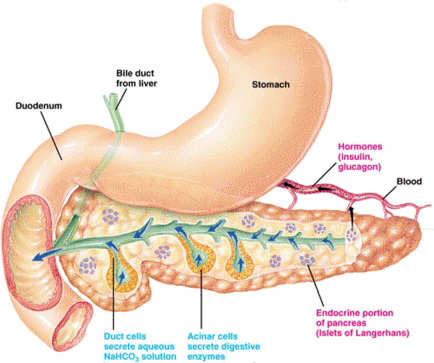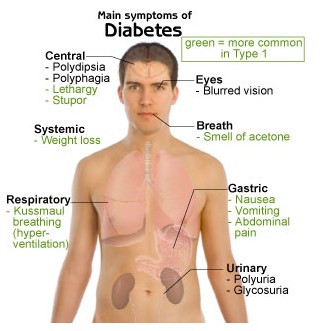

The Pancreas
Digestive Process - Blood Sugar Control
Reprinted from Sunshine Sharing

Where is it located?
The pancreas is located in the abdomen, tucked behind the stomach. It is shaped somewhat like a tadpole - fat at one end and slender at the other - and is around 25cm in length.
What does it do?
The pancreas has dual roles.
1. it is an organ of the digestive system and of the endocrine (hormonal) system. Once food has been mulched and partially digested by the stomach, it is pushed into the duodenum (first part of the small intestine). The pancreas adds its own digestive juices and enzymes to the food, via a small duct attached to the duodenum. This process is said to belong to the "exocrine pancreas".
2. The pancreas also produces the hormone insulin, which helps to control the amount of sugar in the blood. This is the role of the endocrine pancreas.
Symptoms of a diseased pancreas
The symptoms of a diseased pancreas depend on the underlying cause, but may include:
Pain in the upper abdomen
Loss of appetite
Yellowing of the skin and eyes (jaundice)
Back pain
Bloating
Nausea Vomiting
Digestive upsets
Passing foul-smelling and fatty feces.
Key Products for the Pancreas
Read description first prior to making your selection
|
|
|

Just as your liver is tucked under your ribs on the right side, your pancreas
is positioned on the opposite side. It is a pretty pink and looks like a fish
fillet. The head has a duct that allows its digestive compounds to flow into
the small intestine near the stomach. Its tail trails left toward the spleen, a
dark red, lymphatic organ important for immunity and which also acts as
your blood bank.
“Pancreas” is from the Greek, meaning “all flesh,” perhaps referring to
the fact that it produces all sorts of compounds that digest all types of food
after an initial preparation by stomach acids. The pancreas produces both
internal and external secretions.
While the external pancreatic juices flow into the food prepared by the
stomach to further digestion, internal secretions including insulin and
perhaps glucagon, help control blood sugar levels. Just like oxygen is controlled in a car engine, the fuel—in our case, blood sugar—must also be
mixed in just the right amount for most efficient use. Too much sugar "floods” the engine, making it sputter and perhaps “killing” it. Too much
fuel can do the same thing to your body. Likewise, too little fuel makes the
engine lose power and it can also “die” if the least little stress is put on it.
Rather than describe all the pancreatic functions, we are focusing only
on the sugar-controlling ability of the pancreas. The pancreatic cells that
produce insulin are called “islets of Langerhans,” named in honor of the
German anatomist who discovered them in 1869, Paul Langerhans.
What is insulin?
Its name comes from the Latin, meaning “island,” evidently because the cells are scattered like islands around the pancreatic
gland. It is a hormone manufactured in response to a rising blood sugar
level. Its job is to help transport the sugar in the blood across the cell
membrane, which automatically lowers the sugar content of the blood.
Without enough calcium in the blood, the insulin mechanism does not
respond to the rise in blood sugar. So here is the first element we must be
sure is in good supply. Without sufficient chromium, another mineral,
excessive insulin is needed to control sugar levels, which may exhaust the
pancreas over time.
An exhausted pancreas will not be able to control sugar levels, resulting
in a disease known as diabetes millitus. “Diabetes” comes from the Greek
meaning to siphon, referring to excessive urination of water as a diabetic symptom. “Millitus” means honey-sweet, referring to the body’s attempt
to save itself by excreting excessive sugar out of the blood into the urine.
 It has also been discovered that a small amount of selenium, another
mineral, must be present to prevent degeneration of the pancreas itself.
Large areas of cropland in America (especially in the east) are sorely
deficient in selenium.
Medical science came to the rescue in 1921 with the discovery of using
animal pancreas extract to obtain insulin to be administered by injection.
This offered hope to many thousands who waited for death as they went
blind, lost limbs and otherwise wasted away. A careful dietary program was
eventually instituted to help control the sugar entering the blood between
daily injections of insulin.
It has also been discovered that a small amount of selenium, another
mineral, must be present to prevent degeneration of the pancreas itself.
Large areas of cropland in America (especially in the east) are sorely
deficient in selenium.
Medical science came to the rescue in 1921 with the discovery of using
animal pancreas extract to obtain insulin to be administered by injection.
This offered hope to many thousands who waited for death as they went
blind, lost limbs and otherwise wasted away. A careful dietary program was
eventually instituted to help control the sugar entering the blood between
daily injections of insulin.
In recent years it has been discovered that high amounts of insulin in the
blood cause the circulatory system to weaken and the walls of the vessels
to be injured and collect fatty deposits. This is another good reason to increase one’s intake of chromium, which lowers the insulin needed in the
blood to perform its work.
Even though tendencies toward diabetes may be inherited, more important
factors are diet and stress. Nearly everyone knows that the American
diet is deficient in nutrients and over half the population take supplements.
It is easy to see why we allow our bodies to degenerate.
When “empty calories” are eaten, like white flour or white sugar, the
naturally accompanying nutritional elements normally provided by Mother
Nature are generally or completely missing. In order to properly digest this "junk” the body has to withdraw important food elements (like B vitamins,
calcium, etc.) from other organs or tissues to make up for the deficit. After
withdrawing from the body’s savings account for many years, wouldn’t you
expect a breakdown somewhere in the body? The pancreas is one of those
nutrient storage sites that junk food weakens.
Now we’ll talk about how to correct these problems!
Pancreas Remedies
Before you spend any money or hold a pity-party to advertise the sad
condition of your horse-whipped pancreas, do yourself a favor by going
outside and taking a long walk, especially after each meal. This will help
lower your blood sugar and elevate “good mood” hormones. We are not
making fun of the problem. Research has shown that moderate exercise can
benefit diabetics, and walking is a wonderful basic exercise. Besides,
walking is an excellent way to help release the mental/emotional pain which
may be affecting your nerves, circulation and digestive organs.
From an emotional point of view, problems with your pancreas indicate
that something is wrong with the “sugar” in your life. So, do something "sweet” for yourself—you deserve it. If you feel like it, shower some love
on your whole digestive system and thank it for keeping you alive in spite
of the garbage you have thrown into it all these years. And give yourself five minutes to get over your guilt trip for eating
naughty foods.
Now smile, because you are about to solve this problem, and every one
of your trillions of cells is going to help you celebrate with renewed energy
and happiness! And for those using the needle, given some time and the
right decisions, we shall all hope you can throw it away. But do not get too hasty
until you know you are able to control your own sugar levels by repairing
your pancreas! This will be hard for some to believe, but there are people
who have been able to reduce or eliminate their insulin.
Although we are emphasizing diabetes here rather than hypoglycemia,
we know that hypoglycemia can finally result in diabetes if your natural
insulin stops. It turns out that many of the foods and herbs for building the pancreas as listed below will improve both diabetic and hypoglycemic
conditions.
Diet
Diet is probably the chief factor in the development of diabetes.
The disease is common to affluent societies who consume rich, processed
foods but is virtually unknown in societies eating whole, natural foods. So,
allow no more trash into the body, including emotional trash like bad thoughts about yourself.
Fresh foods, raw if possible, like cauliflower,
cabbage, brussels sprouts, dried beans, grains, garlic, onions, horseradish,
dry mustard, nuts, peas, Swiss chard and watercress are all rich in much needed
sulfur.
All green, leafy vegetables contain myrtillin, a sugar lowering
substance. Dr. I. Singh was able to get 3/4ths of his patients off
insulin inoculations with a low-fat diet! And all the rest were able to
significantly reduce their daily insulin needs. Dr. Henry Bieler cured
diabetics by putting them on a strict diet of non-starchy vegetables like
green beans and zucchini squash until their sugar stabilized.
Fiber
Remember that the natural fiber of whole foods can help to govern
how fast simple sugars enter the blood simply by slowing the sugar down.
This is beneficial to the pancreas anyway, whether it is healthy or depleted.
Foods rich in fiber will slow the release of sugar into the blood stream as
well as aid the body in ridding itself of excess cholesterol through the gall
bladder. Psyllium hulls, fenugreek, marshmallow and other mucilaginous
herbs have this affect. So try taking a heaping teaspoon of Psyllium Hulls
Combination or Nature’s Three in a glass of water once per day.
Vitamins/Minerals
A general vitamin and mineral supplement may also
be helpful. In addition, extra amounts of the following minerals and
vitamins may be necessary. Chromium is absolutely essential to proper
pancreatic function. A special form of this mineral, GTF Chromium, has
proven very beneficial to many diabetics.
Zinc is also essential for proper
pancreatic function.
Vitamin E will help prevent/repair damage of insulin
as it circulates through the arteries. However—and this is important—
there is some evidence that it can also help control blood sugar by itself! And
don’t forget Vitamin A, which has also been shown to help diabetics (a
shortage of which contributes to impotence in diabetic men). Just for your
information, one diabetic doctor found that large amounts of Vitamin C lowered his need for insulin shots from 32 to 13 units a day. He took the
vitamin every hour. (He didn’t say how much he took.)
Herbs
Goldenseal is the first herb diabetics ought to take a serious look
at. Goldenseal has an insulin-like effect in the body, meaning it lowers
blood sugar levels. If you are on insulin and start using goldenseal, it is
important to monitor your sugar level carefully, because if the goldenseal
(or any other herbs and supplements you are taking) begin to take effect,
your need for insulin will diminish. In fact, you may wish to have your
doctor monitor your progress occasionally.
Licorice Root has the opposite effect from goldenseal. It tends to raise blood sugar levels or at least to help stabilize them. It works because it aids
the adrenal glands. With blood sugar problems, the adrenals are often called
upon to produce adrenaline to cause the liver to release sugar in the case of
low blood sugar (hypoglycemia). One diabetic woman could tell by how
she felt when her blood sugar was too high or too low. She took licorice to
raise her blood sugar when necessary and goldenseal to lower it.
 Other single herbs which have been used historically to aid pancreatic
function and balance blood sugar levels include: juniper berries, uva ursi, dandelion and burdock.
Other single herbs which have been used historically to aid pancreatic
function and balance blood sugar levels include: juniper berries, uva ursi, dandelion and burdock.
Bilberry, blueberry and huckleberry tend to be very
high in the blood-sugar lowering compound myrtillin.
There are several combinations specifically designed for pancreatic
problems.
Pro-Pancreas (formerly P-14) contains fourteen herbs which have been used to rebuild the
pancreas. It’s chief ingredient is goldenseal, but it also contains juniper, uva
ursi, cedar berries, dandelion and licorice root.
Another pancreatic formula is PBS. The chief
ingredient in this formula is cedar berries, which Dr. John Christopher
found would help rebuild pancreatic function. This formula
also contains goldenseal, burdock and other herbs which aid liver, pancreatic
and adrenal function.
Finally, for hypoglycemia, HY-A is very a useful and popular combination.
Circulation and Diabetes
As we mentioned before, one of the chief complications of diabetes is
circulatory disorders. Many diabetics develop problems with their eyes,
sores on their arms and legs and other problems due to poor blood flow to
the extremeties. Hence, it is vitally important when working nutritionally
Garlic,
capsicum and hawthorn berries (Combination HS II) should be considered
in addition to herbs for the pancreas. In severe cases the Mega Chel program may be essential.
This information is for educational purposes
only. Consult with a qualified
health practictioner for all serious or
persistant illness.
Copyright © 1999 by Robinson & Horne,
L.C., P.O. Box 1028, Roosevelt, UT
84066. This material
may be duplicated for educational purposes
only (not for resale) provided it is
not altered in any way.
|